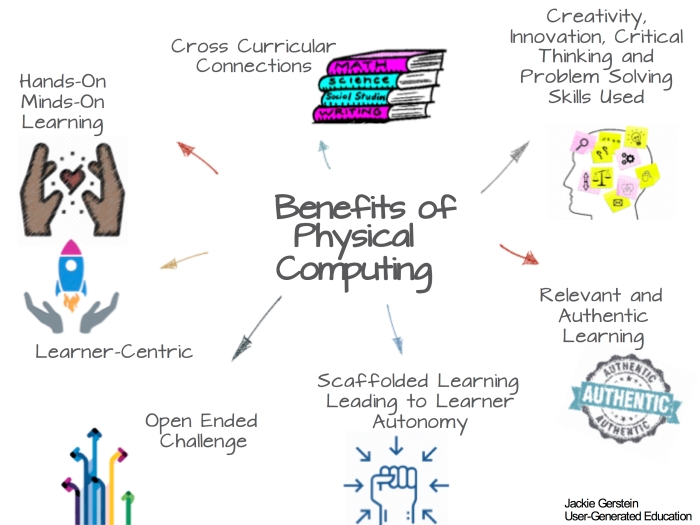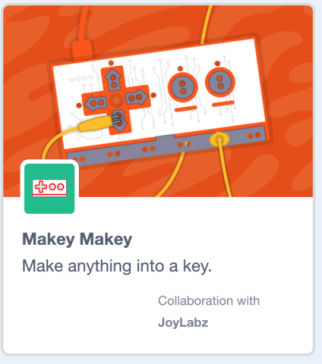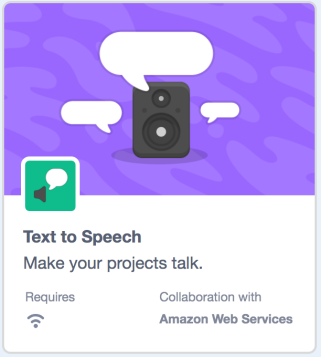Scratch and Makey Makey Across the Curriculum
I love bringing physical computing into my classrooms:
Physical computing means building interactive physical systems by the use of software and hardware that can sense and respond to the analog world. Physical computing is a creative framework for understanding human beings’ relationship to the digital world. In practical use, the term most often describes handmade art, design or DIY hobby projects that use sensors and microcontrollers to translate analog input to a software system, and/or control electro-mechanical devices such as motors, servos, lighting or other hardware (https://en.wikipedia.org/wiki/Physical_computing).
. . . but as with all use of educational technologies, I believe that it should be used intentionally to assist learners in developing and expanding their content knowledge and life skills.
Best Practices for Physical Computing

- Hands-on/Minds-On: “When students are fully engaged in a task, they are actively doing and actively thinking. While hands are engaged, minds should be questioning, sorting through sensory input, and making connections” (Actively Engage Students Using Hands-on & Minds-on Instruction).
- Development of Learning and Innovation as Well as Career and Life Skills: Physical computing activities should be designed to help learners develop skills as identified as by the Partnership for 21st Century Learning.
Learning and innovation skills are what separate students who are prepared for increasingly complex life and work environments in today’s world and those who are not. These skills include: Creativity and Innovation; and Critical Thinking and Problem Solving.
Today’s students need to develop thinking skills, content knowledge, and social and emotional competencies to navigate complex life and work environments. P21’s essential Life and Career Skills include: Flexibility and Adaptability; and Initiative and Self-Direction (Partnership for 21st Century Learning Framework and Resources).
- Cross Curricular Connections: Physical computing, at its best, enbraces content standards across the curriculum.
Multidisciplinary or interdisciplinary learning is a “whole” or “comprehensive” method that covers an idea, topic, or text by integrating multiple knowledge domains. It is a very powerful method of teaching that crosses the boundaries of a discipline or curriculum in order to enhance the scope and depth of learning. Each discipline sheds light on the topic like the facets of a gem. (A Cornucopia of Multidisciplinary Teaching).
- Relevant and Authentic Learning: Physical computing is often perceived by learners of all ages are relevant to their lives especially with the current push towards learning STEM and coding.
Authentic learning is learning designed to connect what students are taught in school to real-world issues, problems, and applications; learning experiences should mirror the complexities and ambiguities of real life. Students work towards production of discourse, products, and performances that have value or meaning beyond success in school; this is learning by doing approach (Authentic learning: what, why and how?)
- Learner-Centric – More of Them; Less of Us:At its heart, maker education and physical computing is about centering around the learner. Children and youth are natural learners—imaginative, curious, exploratory testers of theories and creators of solutions. When children and youth have educational experiences that allow them to fully occupy the educational space and are supported by adults who trust their innate abilities and contributions and are given the guidance, they grow confident in their abilities (At its heart, maker education is always about centering the learner).
- Scaffolded Learning Leading to Learner Autonomy: In Scaffolding Maker Education Learning Experiences, I discussed the following:
Direct instruction is provided through structured and prescribed activities with the goal of learners then being able to eventually go into self-determined directions. My contention is that learners often don’t know what they don’t know; and that giving them the basic skills frees them to then use their creativity and innovation to take these tools into self-determined directions
- Open-Ended Challenge: As stated above, learning is scaffolded but even with more structure projects as described in this post, they are still open-ended enough for learners to integrate their own talents, interests, and skills into the projects.
Note about using Makey Makey and Scratch 3.0
All of the following projects utilized Scratch 3.0 along with their extensions: Makey Makey and for some, Text to Speech.


Language Arts: Character Development
Standards Addressed:
Common Core State Standards – ELA
- Write narratives to develop real or imagined experiences or events using effective technique, relevant descriptive details, and well-structured event sequences.
Next Generation Science Standards
- Define a simple design problem reflecting a need or a want that includes specified criteria for success and constraints on materials, time, or cost.
- Evaluate competing design solutions using a systematic process to determine how well they meet the criteria and constraints of the problem.
National Core Arts Standards
- Students will generate and conceptualize artistic ideas and work.
ISTE Standards for Students
- Students use a variety of technologies within a design process to identify and solve problems by creating new, useful or imaginative solutions.
- Students develop, test and refine prototype as part of a cyclical design process.
- Students exhibit a tolerance for ambiguity, perseverance, and the capacity to work with open-ended problems.
- Students understand how automation works and use algorithmic thinking to develop a sequence of steps to create and test automated solutions.
Directions:
Learners engaged in a maker-enhanced writers’ workshop. I like having my learners begin by developing their characters. They did so by:
- Describing their character.
- Drawing a picture of their characters.
- Creating a more artistic version of their character using additional art materials.
- Posting a description and image of their character onto Kidblog.
- Using Scratch and Makey Makey to describe the main characteristics of their characters.
- More about the Maker-Enhanced Writing Workshop: Character Development can be found at https://usergeneratededucation.wordpress.com/2019/02/17/maker-enhanced-writing-workshop-character-development/
Language Arts: The Monster Project
Standards Addressed:
Common Core State Standards – ELA
- Write narratives to develop real or imagined experiences or events using effective technique, relevant descriptive details, and well-structured event sequences.
National Core Arts Standards
- Students will generate and conceptualize artistic ideas and work.
ISTE Standards for Students
- Students use a variety of technologies within a design process to identify and solve problems by creating new, useful or imaginative solutions.
- Students develop, test and refine prototype as part of a cyclical design process.
- Students exhibit a tolerance for ambiguity, perseverance, and the capacity to work with open-ended problems.
- Students understand how automation works and use algorithmic thinking to develop a sequence of steps to create and test automated solutions.
Directions:
Directions for this project can be found at https://usergeneratededucation.wordpress.com/2023/03/04/monster-project-using-makey-makeys-and-scratch/.
Example Scratch Code: https://scratch.mit.edu/projects/793092586/editor/
Science: Brain Science
Standards Addressed:
Next Generation Science Standards
- Develop a model to describe phenomena.
- Use a model to test interactions concerning the functioning of a natural system.
- Define a simple design problem reflecting a need or a want that includes specified criteria for success and constraints on materials, time, or cost.
- Evaluate competing design solutions using a systematic process to determine how well they meet the criteria and constraints of the problem.
ISTE Standards for Students
- Students use a variety of technologies within a design process to identify and solve problems by creating new, useful or imaginative solutions.
- Students develop, test and refine prototype as part of a cyclical design process.
- Students exhibit a tolerance for ambiguity, perseverance, and the capacity to work with open-ended problems.
- Students understand how automation works and use algorithmic thinking to develop a sequence of steps to create and test automated solutions.
Directions:
- This was part of a larger unit whereby the students were taught about brain science. See https://usergeneratededucation.wordpress.com/2016/10/22/teaching-elementary-level-learners-about-the-brain/.
- I adapted the directions for their brain operation game from https://iamclaudius.com/makey-makey-operation-game/. I gave them an outline of the brain with lobes outlined for them to color and rubber cement onto a pizza box (see video below). For their brain parts, I gave them air drying clay. They were asked to create parts that represent the functions of the individual lobes, e.g., eye for occipital lobe, mouth for temporal lobe, a ball for the cerebellum, etc.
- They were then asked to code their games using Scratch. Here is the example I used to get them started: https://scratch.mit.edu/projects/283935140/editor/. I instructed them to include, for each lobe, its name and some kind of pun about its function.
- Finally, they hooked up the Makey Makey using the directions found at https://iamclaudius.com/makey-makey-operation-game/.
Music: Piano
Standards Addressed:
Music Education
- The creative ideas, concepts, and feelings that influence musicians’ work emerge from a variety of sources.
- Musicians connect their personal interests, experiences, ideas, and knowledge to creating, performing, and responding.
ISTE Standards for Students
- Students exhibit a tolerance for ambiguity, perseverance, and the capacity to work with open-ended problems.
- Students understand how automation works and use algorithmic thinking to develop a sequence of steps to create and test automated solutions.
Directions:
These project used the directions from Scratch Cards, Music Cards, for the Microbit found at https://microbit.org/scratch/. Instead of a microbit, a Makey Makey was used. See the video below.
Engineering: Marble Mazes
Standards Addressed:
Next Generation Science Standards
- Define a simple design problem reflecting a need or a want that includes specified criteria for success and constraints on materials, time, or cost.
- Generate and compare multiple possible solutions to a problem based on how well each is likely to meet the criteria and constraints of the problem.
- Plan and carry out fair tests in which variables are controlled and failure points are considered to identify aspects of a model or prototype that can be improved.
ISTE Standards for Students
- Students use a variety of technologies within a design process to identify and solve problems by creating new, useful or imaginative solutions.
- Students develop, test and refine prototype as part of a cyclical design process.
- Students exhibit a tolerance for ambiguity, perseverance, and the capacity to work with open-ended problems.
- Students understand how automation works and use algorithmic thinking to develop a sequence of steps to create and test automated solutions.
Directions:
- This project was adapted from @gravescolleen Makey Makey Marble Maze and 5th grade https://colleengraves.org/2018/05/04/makey-makey-marble-maze-and-5th-grade/.
Sample Scratch Code: https://scratch.mit.edu/projects/714923121/editor/

Muito obrigado. Excelente material para estudo.
Daniel Peters Gusmão Meira
March 13, 2019 at 11:05 am